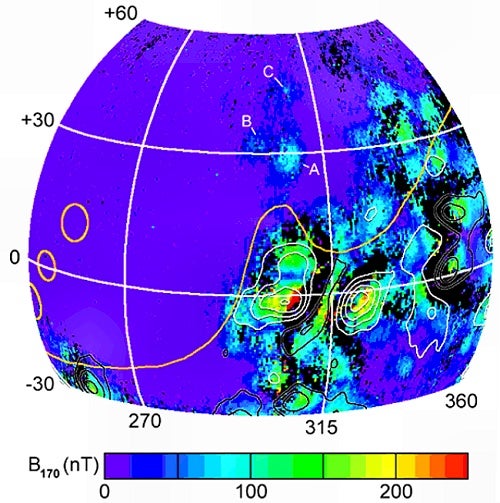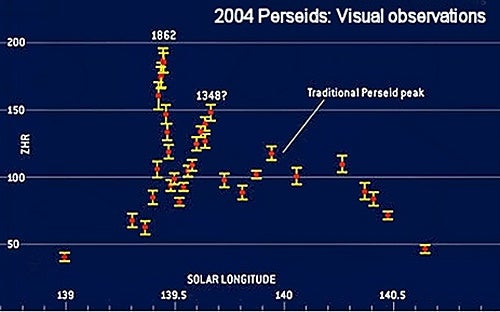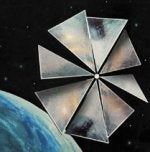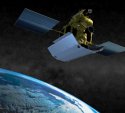Radar may return shuttle to flight
Using radar antennae supplied by the U.S. Navy, NASA observed the launch of the Delta II rocket that sent MESSENGER toward Mercury earlier this month. The ability to track the separation of the solid rocket boosters and other expendable pieces of hardware from the spacecraft during launch has implications for the space shuttle’s return to flight. Radar would allow NASA to monitor not only normal launch activity but also any debris shed during takeoff, such as that deemed responsible for Columbia’s demise last year, regardless of weather conditions. — Laura Baird
Telescope groundbreaking
What produces ultrahigh-energy cosmic rays? Astronomers hope a new observatory will provide an answer. Groundbreaking for the Telescope Array, a joint Japanese and American project, occurred August 26 atop Black Rock Mesa in the Utah desert. The observatory will contain three hilltop fluorescence detectors and 576 scintillation detectors covering nearly 400 square miles (1,025 kilometers) on the ground. The former will detect faint blue flashes in the night sky caused by cosmic rays hitting Earth’s atmosphere, while the latter will measure “showers” of subatomic particles that reach the surface. Construction will take 2 years. — Laura Baird
Mapping magnetic Mars
One of the great surprises from NASA’s Mars Global Surveyor mission was the discovery that the Red Planet’s crust is intensely magnetized. On Earth, the global magnetic field becomes imprinted on cooling crustal rocks. Mars no longer generates a global magnetic field, but did early in its history, and the same process occurred there.
What’s surprising is that martian crust contains magnetic sources 10 times stronger than counterparts on Earth. With few exceptions, these fields occur in the southern highlands, the planet’s oldest terrain. The ancient basins of Hellas, Argyre, and Isidis even appear to have been demagnetized by the heat of the impacts that formed them, which would make magnetized crust among the oldest preserved geologic features on Mars.
Weak fields can escape detection from Mars Global Surveyor’s onboard magnetometer, so a group led by R. J. Lillis of the University of California’s Space Sciences Laboratory used another technique to map out magnetized martian crust. The spacecraft carries an instrument called an Electron Reflectometer, which detects electrons bounced back to space by regions of increased magnetic field on the surface.
The team’s first map, which covers about 20 percent of the Red Planet’s surface, appears in the August 7, 2004, issue of Geophysical Research Letters. It reveals two new magnetic sources in the northern lowlands of Mars and better maps a third source known before. The scientists conclude, “ancient crust is preserved in a significant fraction of the northern lowlands” but covered over by younger material. “In contrast,” they write, “there is no evidence for magnetic sources over most of the Tharsis rise down to our detection threshold,” suggesting this volcanic region contains little ancient crust. The team is extending the map’s coverage to the rest of Mars. — Francis Reddy
The Perseids is among the year’s most observed meteor showers. This year, experts predicted a modest outburst from the Perseids just prior to its annual peak. According to the most recent analysis of reports submitted to the International Meteor Organization (IMO), a worldwide association of visual meteor observers, the expected outburst did occur. The shower reached a Zenithal Hourly Rate of 187 meteors at 20h56m UT on August 11 — just 2 minutes from the peak forecast by Finnish researcher Esko Lyytinen. IMO’s Rainer Arlt cautions that “it cannot be excluded that observers’ prejudice has ‘helped’ match this forecast,” a problem video observations may help resolve.
The Perseids also produced enhanced activity throughout the nights of August 11/12 and 12/13, which was also consistent with Lyytinen’s prediction, says Arlt. Both the outburst and the enhanced activity resulted from the action of Jupiter’s gravity on the particles making up the Perseid stream. — Francis Reddy
NASA’s Mars Odyssey orbiter has made significant discoveries in its career, including the prevalent existence of the mineral olivine and high levels of frozen water in relatively warm regions on the Red Planet. Now having completed its primary goals, the orbiter will extend its mission.
“This extension gives us another martian year to build on what we have already learned,” explains Jeff Plaut, project scientist for Odyssey. “One goal is to look for climate change.
During the prime mission, we tracked dramatic seasonal changes, such as the comings and goings of polar ice, clouds, and dust storms. Now, we have begun watching for year-to-year differences at the same time of year.”
This continuation also allows Odyssey to support the twin rovers, Spirit and Opportunity; most rover images are relayed to Earth via the orbiter. Odyssey also will monitor Mars’s atmospheric conditions to assist NASA’s Mars Reconnaissance Orbiter, due to reach the planet in March 2006. — Jeremy McGovern
Very Large Telescope receives new tool
The European Southern Observatory’s Very Large Telescope (VLT) recently received a new optics instrument that will enhance its observing capabilities, improving its ability to study interstellar nurseries and distant galaxies. This instrument, the Spectrograph for INtegral Field Observation in the Near-Infrared (SINFONI), is the first of its type for a scope in the VLT’s class.
SINFONI hit first light July 9 and was tested over the subsequent 2 weeks with rigorous observations. — Jeremy McGovern
Solar sail milestone
The Space Research Institute in Moscow has concluded testing of mission control software and flight electronics for Cosmos 1, meaning that the solar sail project is closer to launch. Sponsored by the Cosmos Studios, this Planetary Society mission hopes to perform the first controlled solar sail flight.
“This long-anticipated and crucial milestone gives us the green light to begin final assembly of the spacecraft,” says Louis Friedman, Executive Director of the Planetary Society and Project Director of Cosmos 1. “If all goes well, we plan to ship the spacecraft to the launch preparation site near the port of Murmansk by the end of November.”
Cosmos 1 will be carried aboard a Volna rocket launched from a Russian submarine beneath the Barents Sea. Primarily selected due to its relative affordability, the launch method was also chosen because it is easier to transport Cosmos 1 from Moscow to Murmansk. — Jeremy McGovern
Future missions will look for origins
NASA recently selected nine studies from 26 submissions to investigate further for its Astronomical Search for Origins Program. Each of the nine studies listed below will have 8 months to develop and refine its concept for a mission that would complement the program’s ongoing science goals. The Origins Program seeks to understand where we came from and whether we are alone in the universe. — Laura Baird
-
- Studying the far-infrared universe, BLISS will enable spectroscopy of some of the farthest galaxies known. The principal investigator for BLISS is Matt Bradford of the Jet Propulsion Laboratory in Pasadena, California.
-
- The Origins Billion Star Survey (OBSS) will survey extrasolar planets within our solar system and study stars within 30,000 light-years of the Sun. The principal investigator for OBSS is Kenneth Johnston of the U.S. Naval Observatory in Washington.
-
- The very high angular resolution of the Space Infrared Interferometric Telescope (SPIRIT) will advance research about star and planet formation. This principal investigator for SPIRIT is David Leisawitz of the Goddard Space Flight Center in Greenbelt, Maryland.
-
- By conducting a space-based near-infrared large-area redshift survey, the Cosmic Inflation Probe (CIP) will detect galaxies that formed during the early universe. The principal investigator for CIP is Gary Melnick of the Smithsonian Astrophysical Observatory in Cambridge, Massachusetts.
-
- In addition to investigating star formation, the High Orbit Ultraviolet-visible Satellite (HORUS) will probe the origin of elements and cosmic structures as well as the compositions of atmospheres on extrasolar planets. The principal investigator for HORUS is Jon Morse of Arizona State University.
-
- The Hubble Origins Probe aims to use tools developed for the fifth Hubble servicing mission, which was cancelled, to focus on the time when star and planet formation was at its highest. The principal investigator for this study is Colin Norman of Johns Hopkins University in Baltimore.
-
- An infrared space telescope called ASPIRE (Astrobiology SPace InfraRed Explorer) will hunt for organic compounds in deep space and around other stars using spectroscopy. Such compounds are building blocks for life. The mission’s principal investigator is Scott Sandford of NASA’s Ames Research Center at Moffett Field, California.
-
- By mapping matter in the early universe, the Baryonic Structure Probe will bolster observational cosmology. The principal investigator for this project is Kenneth Sembach of the Space Science Telescope Institute in Baltimore.
- The Galaxy Evolution and Origins Probe (GEOP) will observe more than 5 million galaxies to study long-term changes in star formation as well as in galaxy size and brightness. The principal investigator for GEOP is Rodger Thompson of the University of Arizona.
Storm delays MESSENGER liftoff
The launch of the MESSENGER space probe to Mercury, scheduled for August 2, 2004, was scrubbed because of bad weather from Tropical Storm Alex. Flight controllers will next attempt to launch the spacecraft at 2:16 A.M., August 3rd.
— Robert Burnham
Visiting Mars through the web
Initially a tool providing scientists with data and helping them select potential landing sites on Mars, a NASA web site has evolved to serve the general public. Marsoweb allows all visitors to use tools to explore wide, immense regions or finer details of the Red Planet’s surface.
Marsoweb changes occurred largely due to the overwhelming response the site received in January, after the Mars Exploration Rover Spirit landed on Mars. The site encountered over 26.7 million hits in the month following the landing.
“An interactive data map on Marsoweb allows users to view most Mars data including images, thermal inertia, geologic and topographical maps and engineering data that includes rock abundance,” says Virginia Gulick from NASA’s Ames Research Center.
“The engineering data give scientists an idea of how smooth or rocky the local surface is.”
NASA researchers plan to encourage visitors to survey Mars virtually in search of significant geologic features hidden in thousands of surface images. Beginning in November 2006, researchers hope volunteers will help with imaging from an upcoming Mars imaging mission. Aboard the Mars Reconnaissance Orbiter, the High Resolution Imaging Science Experiment (HiRISE) will image objects about a meter wide on the Red Planet’s surface.
“We will ask volunteers to help us create geologic feature databases of boulders, gullies, craters — any kind of geologic feature that may be of interest,” says Gulick. “Scientists or students can use these databases to propose theories about Mars that could be proven by future exploration.” — Jeremy McGovern














